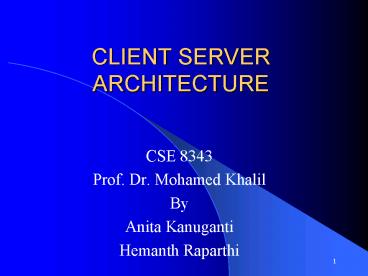CLIENT SERVER ARCHITECTURE PowerPoint PPT Presentation
1 / 19
Title: CLIENT SERVER ARCHITECTURE
1
CLIENT SERVER ARCHITECTURE
- CSE 8343
- Prof. Dr. Mohamed Khalil
- By
- Anita Kanuganti
- Hemanth Raparthi
2
Topics
- Introduction
- Overview Of Different Architectures
- Client/Server Architecture
- File Sharing Architecture
- Mainframe Architecture
- Examples of Client Server Architectures
- Two-tier Architecture
- Three-tier/Multi-tier Architecture
- Three-tier architecture with transaction
processing monitor technology - Three tier with an application server
- Three tier with message server
- Distributed /collaborative enterprise
architecture - Conclusions
3
Main Frame architecture
- With Mainframe software architectures all
intelligence is within the central host computer - A limitation of mainframe software architectures
is that they do not easily support graphical user
interfaces or access to multiple databases from
geographically dispersed sites
4
File Sharing Architecture
- The original PC networks were based on file
sharing architectures - File sharing architectures work if shared usage
is low, update contention is low, and the volume
of data to be transferred is low
5
Client/Server Architecture
- As a result of the limitations of file sharing
architectures, the client/server architecture
emerged - A Database server replaced the File server
- Network traffic was reduced, because user queries
could be answered directly.
6
Types of Client/Server Architectures
- Two Tier Architecture
- Three Tier Architecture
7
Two Tier Architecture
- Architecture
- User Interface (requester of services)
- Server Interface (provider of services)
- Advantages
- Improves Scalability
8
Two-Tier Architecture cont.
- Non-Complex
- Non-time Critical information processing system
- User Interface in User side, database management
in the server side
9
Two Tier Architecture Cont.
- Disadvantages
- Performance Detoriats if more than 100 users are
involved - Interoperability is limited
- System Administration is difficult
10
Usage of Two Tier Architecture
- Two tier software architectures are used
extensively in non-time critical information
processing - This design is used frequently in decision
support systems where the transaction load is
light. - The two tier architecture works well in
relatively homogeneous environments with
processing rules (business rules) that do not
change very often and when workgroup size is
expected to be fewer than 100 users, such as in
small businesses.
11
Three Tier Architecture
- Architecture
- Advantages
- It overcomes all the disadvantages of Two Tier
Architecture, by providing a middle layer
12
Three Tier Architecture cont.
- Disadvantages
- The development environment is more difficult to
use, than the Two Tier development environment - The cost involved is much more than the Two tier
Architecture
13
Three Tier Architecture cont.
- Usage of Three tier Architecture
- Used in distributed Client/Server Architecture.
That provides flexibility,etc. - Used in Internet applications
- Used in net-centric applications
14
Different Implementations
- Three-tier architecture with transaction
processing monitor technology - The basic type of Three Tier Architecture
- The middle layer consists of Transaction
Processing TP monitor technology. - This focuses on the intelligence in the monitor
15
Different Implementations cont.
- Three Tier with Message Server
- This consists of headers
- This focuses on Intelligent messages
- Good solutions for wire less infrastructure
16
Different implementations cont
- Three tier with an Application Server
- Application Oriented
- Application runs on a shared environment
- Hence less security to worry about
- This architecture can be used, when Security,
Scalability, Cost are the major considerations
17
Different Implementations cont.
- Distributed /collaborative enterprise
architecture - An enterprise is defined , as a system comprised
of multiple business systems or subsystems
18
Conclusion
- Usage Considerations
- Cost Limitations
- Dependencies
- Alternatives
- Complementary Technologies
19
Bibliography
- "Client/Server Computing--Architecture,
Applications and Distributed Systems
Management by Bruce Elbert, Bobby Martyna - "Client/Server Architecture by Alex Berson
- Dickman, A. "Two-Tier Versus Three-Tier Apps."
InformationWeek 553 (November 13,
1995) 74-80. - Gallaugher, J. Ramanathan, S. "Choosing a
Client/Server Architecture. A Comparison of
Two-Tier and Three-Tier Systems." Information
Systems Management Magazine 13, 2 (Spring 1996)
7-13. - Edelstein, Herb. "Unraveling Client/Server
Architecture." DBMS 7, 5 (May 1994) 34(7). - Newell, D. Jones, O. Machura, M.
"Interoperable Object Models for Large Scale
Distributed Systems," 30-31. Proceedings.
International Seminar on Client/Server Computing.
La Hulpe, Belgium, October 30-31, 1995. London,
England IEE, 1995

